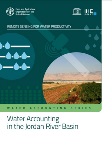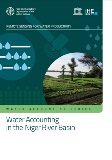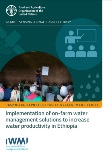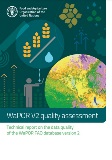Water accounting
Understanding the current status of water resources systems globally requires detailed information on the source of water in space and time as well as detailed information on the utilisation of those water resources. Unavailability of sufficient observed data is a big issue in most parts of the world to be able to fully assess available water resources and its utilisation. Fortunately, more and more remote sensing based products are becoming available, providing information on various components of the water cycle, such as precipitation, actual evapotranspiration and storage variations.

Water accounting in the Jordan River Basin
04/06/2020
This report describes the rapid water accounting study for the Jordan River Basin using the Water Productivity (WaPOR) database. The water accounting has been carried out in collaboration with IHE Delft using the FAO Water Productivity (WaPOR) data portal, to gain full insights into the state of the water resources in the basin for the period from 2009 to 2018.

Water accounting in the Nile River Basin
04/08/2020
The Nile River Basin faces a huge challenge in terms of water security. With an expected doubling of the population in the basin in the next twenty-five years, water supply in the basin will be further depleted as demands for agriculture, domestic and industry continues to grow. This report describes the water accounting study for the Nile River Basin carried out by IHE-Delft using the Water Productivity (WaPOR) data portal of the Food and Agricultural Organization (FAO).
.tmb-th600x450.jpg?Culture=en&sfvrsn=f9ae6da1_2)
WaPOR database methodology- version 2 release (April 2020)
15/09/2020
WaPOR Version 2 was launched in June 2019 based on extensive internal and external validation and quality assessment. This report describes the methodology used to produce the different data components of WaPOR Version 2 at the 250m (Level 1), 100m (Level 2) and 30m (Level 3) resolution, as made available through WaPOR version 2.0 release.

Water accounting in the Niger River Basin
01/02/2018
WaPOR Version 2 was launched in June 2019 based on extensive internal and external validation and quality assessment. This report, developed in collaboration with ITC-Twente and the other partner of the FRAME Consortium, provides a quality evaluation of the WaPOR V2 evapotranspiration, biomass and water productivity data across Africa and the Near East, currently distributed through the FAO's WaPOR portal.

Implementation of on-farm water management solutions to increase water productivity in Ethiopia
21/12/2021
This technical report focuses on Koga, in Ethiopia, and describes the process of developing, designing, piloting and evaluating potential solutions to increase water productivity sustainably, which is the third objective of component 4 of the WaPOR project. It uses WaPOR data to measure the changes occurring after the implementation of low-cost tools and irrigation practices so as to: increase yield and to reduce the water consumed or applied during the irrigation season.

Water productivity analyses using WaPOR: the case of sugarcane
26/04/2022
This document explores the use of WaPOR data in the context of sugarcane production. Two different case studies of sugarcane estates are explored: the case of Wonji, in Ethiopia, and the case of Xinavane, in Mozambique.

WaPOR V2 quality assessment - Technical report on the data quality of the WaPOR FAO database version 2
15/01/2018
WaPOR Version 2 was launched in June 2019 based on extensive internal and external validation and quality assessment. This report, developed in collaboration with ITC-Twente and the other partner of the FRAME Consortium, provides a quality evaluation of the WaPOR V2 evapotranspiration, biomass and water productivity data across Africa and the Near East, currently distributed through the FAO's WaPOR portal.
